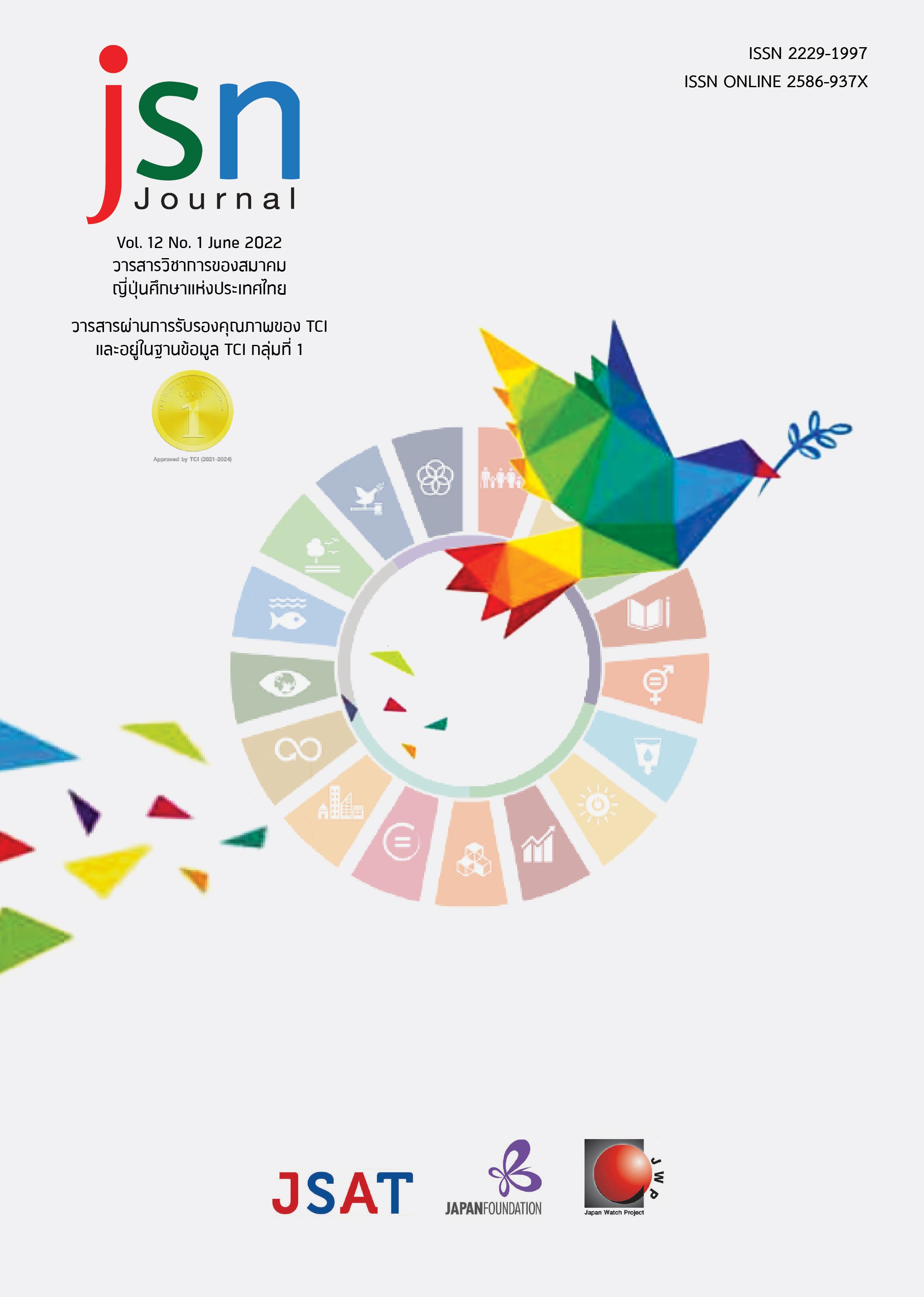The Problems of Coherence in Japanese Composition A Case Study of Thai Students Majoring in Japanese
Main Article Content
Abstract
The objective of this research was to study the problems of coherence in Japanese compositions written by Thai undergraduate students majoring in Japanese. Most participants passed JLPT N2. After analyzing the structure and coherence of 23 Japanese compositions, four main problems were identified. The most common problem is the lack of unified content. At the overall structure, the participants tended to write a summary or introduction that was not consistent with the main idea. At the paragraph structure, the supporting sentence or concluding sentence was boader than the topic sentence. The second problem is the lack of consistency between the content and topic. Some participants wrote main idea or detailed content that was broader than the topic. The third problem is poorly organized content or redundancy. For example, some participants wrote details that were mentioned in the introduction again in a body or wrote the supporting sentence after the concluding sentence in the same paragraph.The fourth problem is the lack of unity in terms of word use and sentence structure. Some words in a summary were different from ones used in an introduction or body. Besides, the wrong usages in sequence connectors were identified. The researcher found that, it is vital to make learners understand the structure of a composition and the relationships between the meanings of all the sentences. The analysis framework of the four problems of coherence above explains a practical way to maintain the unity of content and can be used to develop guidelines for teaching Japanese composition.
Article Details

This work is licensed under a Creative Commons Attribution-NonCommercial-NoDerivatives 4.0 International License.
ข้อความและข้อคิดเห็นต่างๆ ในบทความเป็นของผู้เขียนบทความนั้นๆ ไม่ใช่ความเห็นของกองบรรณาธิการหรือของวารสาร jsn Journal
References
จันทิมา อังคพณิชกิจ. (2561). การวิเคราะห์ข้อความ. กรุงเทพฯ: มหาวิทยาลัยธรรมศาสตร์.
สมเกียรติ เชวงกิจวณิช. (2547). การเชื่อมประโยคในเรียงความภาษาญี่ปุ่นของผู้ศึกษาภาษาญี่ปุ่นชาวไทย.
วารสารศิลปศาสตร์ มหาวิทยาลัยธรรมศาสตร์ ปีที่4(1), 48-67
สมเกียรติ เชวงกิจวณิชและชิซุกุ ยานางิซาวะ. (2560). เทคนิคพื้นฐานการเขียนเรียงความภาษาญี่ปุ่น. กรุงเทพฯ: สมาคมส่งเสริมเทคโนโลยี (ไทย-ญี่ปุ่น).
De Beaugrande, R.A. & Dressler, W.U. (1981). Introduction to text linguistics. London: Longman.
Halliday, M.A.K. & Hasan, R. (1976). Cohesion in English. London: Longman.
浅井美恵子 (2002).「日本語作文における文の構造の分析―日本語母語話者と中国語母語の上級日本語学習者の作文比較―
日本語教育』115. 51-60.
石黒圭 (2011). 「文章理解における一貫性の把握について」『一橋大学国際教育センター紀要』2, 3-11.
石黒圭・筒井千絵 (2009).『留学生のためのここが大切文章表現のルール』スリーエーネットワーク.
池田嘉彦 (1983).「テクストとテクストの構造」『日本語教育指導参考書11 談話の研究と教育Ⅰ』7-42. 国立国語研究所.
門脇薫 (1999).「初級における作文指導―談話展開を考慮した作文教材の試み―」『日本語教育』102, 50-59.
小森万里・内藤真理子 (2015).「アカデミック・ライティングにおける一貫性とは―学習者・教員双方がレポート評価に利
用できるチェックリストの提案―」『日本語・日本語教育研究』6, 205-220.
小森万里・内藤真理子 (2016).「アカデミック・ライティングにおける重複がもたらす冗長性を回避するための方策―卓立
性・結束性・論理性・一貫性の観点からの分析―『日本語教育』164, 1-16.
田代ひとみ (2009). 「読み手の評価別に見た日本語学習者の意見文の問題点」『横浜国立大学留学生センター教育研究論集』16, 75-97.
田中真理・阿部新 (2014).『Good Writingへのパスポート―読み手と構成を意識した日本語ライティング―』くろしお.
田中真理・坪根由香里・初鹿野阿れ (1998).「第二言語としての日本語における作文評価基準―日本語教師と一般日本人の
比較―」『日本語教育』96, 1-12.
田中真理・坪根由香里 (2011).「第二言語としての日本語小論文におけるGood Writing評価-そのプロセスと決定要因」社会言語科学』14(1), 210-222.
張珍華 (2012).「中級日本語学習者の推敲作文における結束性の分析―『総合活動型日本語教』の教室活動を対象に―」『日本文化研究』42, 421-437.
長谷川哲子・堤良一 (2012). 「意見文の分かりやすさを決めるのは何か? : 大学教員による作文評価を通じて」『関西学院
大学日本語教育センター紀要』1, 7-18.
Pattarawan Youyen・太田卓志・山口雅代・吉田直子 (2002). 中級作文におけるタイ人学習者の誤用分析―チェンマイ大学日本語科の学習者を例として―」『国際交流基金バンコク日本語センター紀要』5, 97-112.
藤森弘子 (2005).「結束性の観点からみた初級日本語学習者の作文」 東京外国語大学留学生日本語教育センター論集』31, 95-109.
森本一樹 (2016).「中級日本語学習者の作文における語彙使用の誤用と問題点」『日本語学習者の母語・地域性をふまえた日本語教育研究』2, 99-106.


